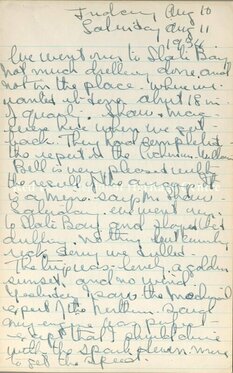Cochenour-Willans Gold Mines
1939 to 1971
Produced 1,244,279 oz.
Produced 1,244,279 oz.
 Margaret Cochenour's diary entry on August 10, 1934 - Donated by Ute Fahlgren
Margaret Cochenour's diary entry on August 10, 1934 - Donated by Ute Fahlgren
Constructing Cochenour-Willans
Brothers Edward (Ed) and William (Bill) Cochenour formed Cochenour-Willans Gold Mines (Cochenour-Willans) with their partner Dan Willans in the 1930’s. However, the Cochenour brothers were among the earliest prospectors to arrive in Red Lake after the Howey Discovery. They staked what would become Buffalo Red Lake Mines in the fall of 1925. In 1926, the Cochenour brothers and Dan Willans staked 13 mining claims in Dome Township. The trio formed the Cochenour-Willans Syndicate in 1928, gathering investors to fund exploration.
Development of the Cochenour-Willans claims began in 1928. The Cochenour-Willans Syndicate performed basic stripping and trenching before they started optioning the property to other companies. Ventures Limited took an option on the property from October to November 1932, performing limited surface development and diamond drilling. Hollinger Consolidated Gold Mines optioned the property from late 1932-1936, sinking a 95.16-metre (312-foot) shaft.
In 1934, Bill Cochenour hired W.P. Mackle and John Shaw from McKenzie Red Lake Gold Mines to evaluate the property. The two mining engineers saw promise in the project. On August 10, 1934, Margaret Cochenour (Bill’s wife) wrote in her diary ‘They [Mackle and Shaw] had finished with the report on Cochenour Willans...It is a mine says Mr. Shaw.’ Less than two years later Cochenour-Willians was created.
Cochenour-Willans incorporated on April 9, 1936, with Bill and Ed Cochenour at the helm as president and vice-president. Unfortunately, Dan Willans also disappeared without a trace in 1936. Although the Cochenours searched for Willans, they had a mine to develop. While Cochenour-Willans had Toronto-based investors, Margaret Cochenour’s inheritance was also used to help bring the mine into production. Mackle was hired to develop the claims and find a viable ore body. Between 1936 and 1937, Cochenour-Willans completed 3,048 metres (10,000 feet) of diamond drilling and underground development. The shaft was extended in 1939 to a depth of 121.9 metres (400 feet). Construction of the mill began in August 1939 and was completed by early December.
1939-1971: The Producing Years
Cochenour-Willans went into production in early 1939, processing the initial stockpiled ore at Gold Eagle Mines on McKenzie Island. The mine poured its first brick on February 9, 1939. The mill at Cochenour-Willans went into production in December 1939. Cochenour-Willans went on to be one of the district’s top producers, operating consistently for 32 years. Operations were temporarily suspended in 1944 due to supply and labour shortages. After the Second World War ended, work at the mine resumed. By 1963, Cochenour-Willans increased their mill capacity, updated equipment and the shaft reached 685.5 metres (2,249 feet) with 18 developed levels.
Like many of the other producing mines in Red Lake during this period Cochenour-Willans expanded their holdings. In 1944, Cochenour-Willans bought neighbouring claims from Kelson Red Lake Mines. In 1961, the mine partnered with Martin McNeely Mining to create Wilmar Mines. In 1965, Annco Mines was established to take over a series of claims from Wilmar Mines. The Cochenour-Willans mill processed ore from both Wilmar and Annco Mines.
Although the mine did not close until 1975, Cochenour-Willans ceased production on August 31, 1971. The mine produced 1,244,279 ounces of gold, worth an estimated $41,362,230. Cochenour-Willans paid more than $6.2 million to their shareholders.
Brothers Edward (Ed) and William (Bill) Cochenour formed Cochenour-Willans Gold Mines (Cochenour-Willans) with their partner Dan Willans in the 1930’s. However, the Cochenour brothers were among the earliest prospectors to arrive in Red Lake after the Howey Discovery. They staked what would become Buffalo Red Lake Mines in the fall of 1925. In 1926, the Cochenour brothers and Dan Willans staked 13 mining claims in Dome Township. The trio formed the Cochenour-Willans Syndicate in 1928, gathering investors to fund exploration.
Development of the Cochenour-Willans claims began in 1928. The Cochenour-Willans Syndicate performed basic stripping and trenching before they started optioning the property to other companies. Ventures Limited took an option on the property from October to November 1932, performing limited surface development and diamond drilling. Hollinger Consolidated Gold Mines optioned the property from late 1932-1936, sinking a 95.16-metre (312-foot) shaft.
In 1934, Bill Cochenour hired W.P. Mackle and John Shaw from McKenzie Red Lake Gold Mines to evaluate the property. The two mining engineers saw promise in the project. On August 10, 1934, Margaret Cochenour (Bill’s wife) wrote in her diary ‘They [Mackle and Shaw] had finished with the report on Cochenour Willans...It is a mine says Mr. Shaw.’ Less than two years later Cochenour-Willians was created.
Cochenour-Willans incorporated on April 9, 1936, with Bill and Ed Cochenour at the helm as president and vice-president. Unfortunately, Dan Willans also disappeared without a trace in 1936. Although the Cochenours searched for Willans, they had a mine to develop. While Cochenour-Willans had Toronto-based investors, Margaret Cochenour’s inheritance was also used to help bring the mine into production. Mackle was hired to develop the claims and find a viable ore body. Between 1936 and 1937, Cochenour-Willans completed 3,048 metres (10,000 feet) of diamond drilling and underground development. The shaft was extended in 1939 to a depth of 121.9 metres (400 feet). Construction of the mill began in August 1939 and was completed by early December.
1939-1971: The Producing Years
Cochenour-Willans went into production in early 1939, processing the initial stockpiled ore at Gold Eagle Mines on McKenzie Island. The mine poured its first brick on February 9, 1939. The mill at Cochenour-Willans went into production in December 1939. Cochenour-Willans went on to be one of the district’s top producers, operating consistently for 32 years. Operations were temporarily suspended in 1944 due to supply and labour shortages. After the Second World War ended, work at the mine resumed. By 1963, Cochenour-Willans increased their mill capacity, updated equipment and the shaft reached 685.5 metres (2,249 feet) with 18 developed levels.
Like many of the other producing mines in Red Lake during this period Cochenour-Willans expanded their holdings. In 1944, Cochenour-Willans bought neighbouring claims from Kelson Red Lake Mines. In 1961, the mine partnered with Martin McNeely Mining to create Wilmar Mines. In 1965, Annco Mines was established to take over a series of claims from Wilmar Mines. The Cochenour-Willans mill processed ore from both Wilmar and Annco Mines.
Although the mine did not close until 1975, Cochenour-Willans ceased production on August 31, 1971. The mine produced 1,244,279 ounces of gold, worth an estimated $41,362,230. Cochenour-Willans paid more than $6.2 million to their shareholders.
Creating Community
Like the rest of the communities in the Red Lake area, the town of Cochenour began as a mining settlement. As the mine grew, so did the community. Miners with families stayed in company-built housing developments, while single miners remained at the company bunkhouses. Cochenour-Willans supported the growth of the community they created and provided many of Cochenour’s amenities over the years. Cochenour-Willans built or supported a United Church, grocery store, school and hospital as well as community clubs and public works. The mine provided materials and supervision for the building of the community’s recreation facilities, while the miners volunteered their time as labourers.
The bond between Cochenour-Willans and the community was strong from the beginning. Every year, the mine provided children with Christmas presents, and Bill Cochenour even hired a figure skating coach for the young girls in the community. The Cochenours also established a trust fund that was used to support recreation and health care projects throughout the years. The mine and the Cochenour’s commitment to the community continued even after elected officials took control. While commerce in the community has diminished since the mine closed, the community still has a thriving population.
Post-Production: September 1971-Present
Even though Cochenour-Willans stopped producing in late 1971, the mine site has had a steady flow of activity over the last five decades. The mine officially closed in 1975, and the company changed its name to Wilanour Resources in 1979. Between 1980 and 1991, Wilanour Resources was in a series of joint ventures with different mining companies to continue doing exploration on the Cochenour-Willans property. These companies included Camflo Mines (1980-1983), Esso Minerals (1984-1987) and Inco Mines (1987-1991). During this period Wilanour Resources did not limit its exploration efforts to the Cochenour-Willans property but also those of Annco Mines, Wilmar Mines and Buffalo Red Lake Mines. Ore collected from the Buffalo Red Lake Mines during 1980-1983 was milled at Cochenour-Willans.
In 1995 Wilanour Resources began selling its mining assets to Goldcorp Inc. Goldcorp gained 100% ownership of Wilanor Resources and the Cochenour-Willans site in 1997. From 1999 to 2004 Goldcorp performed over 27,000 metres (88,583 feet) of diamond drilling, trenching, mapping, geophysical surveys, soil geochemistry and compiled historical data. Beginning in 2009, the Cochenour-Willans shaft was dewatered to access the Bruce Channel deposit. Goldcorp also refurbished the shaft and constructed a new headframe and hoist. Today, the Cochenour-Willans property remains part of Goldcorp’s Red Lake holdings and has potential as a new source of ore for the company.
Like the rest of the communities in the Red Lake area, the town of Cochenour began as a mining settlement. As the mine grew, so did the community. Miners with families stayed in company-built housing developments, while single miners remained at the company bunkhouses. Cochenour-Willans supported the growth of the community they created and provided many of Cochenour’s amenities over the years. Cochenour-Willans built or supported a United Church, grocery store, school and hospital as well as community clubs and public works. The mine provided materials and supervision for the building of the community’s recreation facilities, while the miners volunteered their time as labourers.
The bond between Cochenour-Willans and the community was strong from the beginning. Every year, the mine provided children with Christmas presents, and Bill Cochenour even hired a figure skating coach for the young girls in the community. The Cochenours also established a trust fund that was used to support recreation and health care projects throughout the years. The mine and the Cochenour’s commitment to the community continued even after elected officials took control. While commerce in the community has diminished since the mine closed, the community still has a thriving population.
Post-Production: September 1971-Present
Even though Cochenour-Willans stopped producing in late 1971, the mine site has had a steady flow of activity over the last five decades. The mine officially closed in 1975, and the company changed its name to Wilanour Resources in 1979. Between 1980 and 1991, Wilanour Resources was in a series of joint ventures with different mining companies to continue doing exploration on the Cochenour-Willans property. These companies included Camflo Mines (1980-1983), Esso Minerals (1984-1987) and Inco Mines (1987-1991). During this period Wilanour Resources did not limit its exploration efforts to the Cochenour-Willans property but also those of Annco Mines, Wilmar Mines and Buffalo Red Lake Mines. Ore collected from the Buffalo Red Lake Mines during 1980-1983 was milled at Cochenour-Willans.
In 1995 Wilanour Resources began selling its mining assets to Goldcorp Inc. Goldcorp gained 100% ownership of Wilanor Resources and the Cochenour-Willans site in 1997. From 1999 to 2004 Goldcorp performed over 27,000 metres (88,583 feet) of diamond drilling, trenching, mapping, geophysical surveys, soil geochemistry and compiled historical data. Beginning in 2009, the Cochenour-Willans shaft was dewatered to access the Bruce Channel deposit. Goldcorp also refurbished the shaft and constructed a new headframe and hoist. Today, the Cochenour-Willans property remains part of Goldcorp’s Red Lake holdings and has potential as a new source of ore for the company.
For more information on the Cochenour-Willans subsidiaries click below
